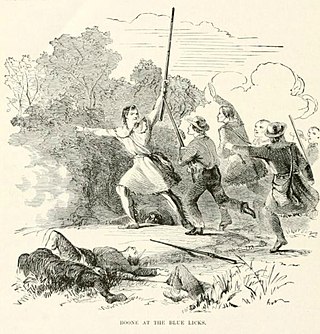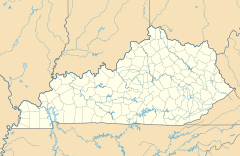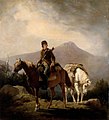
Daniel Boone was an American pioneer and frontiersman whose exploits made him one of the first folk heroes of the United States. He became famous for his exploration and settlement of Kentucky, which was then beyond the western borders of the Thirteen Colonies. In 1775, Boone blazed the Wilderness Road through the Cumberland Gap and into Kentucky, in the face of resistance from American Indians, for whom the area was a traditional hunting ground. He founded Boonesborough, one of the first English-speaking settlements west of the Appalachian Mountains. By the end of the 18th century, more than 200,000 people had entered Kentucky by following the route marked by Boone.

Hurstbourne is a home rule-class city in Jefferson County, Kentucky, United States. The population was 4,216 at the 2010 census, up from 3,884 at the time of the 2000 U.S. census. It is part of the Louisville Metro Government.

Lord Dunmore's War, also known as Dunmore's War, was a brief conflict in fall 1774 between the British Colony of Virginia and the Shawnee and Mingo in the trans-Appalachian region of the colony south of the Ohio River. Broadly, the war included events between May and Oct., 1774. The governor of Virginia during the conflict was John Murray, 4th Earl of Dunmore, who in May, 1774, asked the House of Burgesses to declare a state of war with the Indians and call out the Virginia militia.

The Battle of Blue Licks, fought on August 19, 1782, was one of the last battles of the American Revolutionary War. The battle occurred ten months after Lord Cornwallis's surrender at Yorktown, which had effectively ended the war in the east. On a hill next to the Licking River in what is now Robertson County, Kentucky, a force of about 50 Loyalists along with 300 indigenous warriors ambushed and routed 182 Kentucky militiamen, who were partially led by Daniel Boone. It was the last victory for the Loyalists and natives during the frontier war. British, Loyalist and Native forces would engage in fighting with American forces once more the following month in Wheeling, West Virginia, during the Siege of Fort Henry.

The western theater of the American Revolutionary War (1775–1783) was the area of conflict west of the Appalachian Mountains, the region which became the Northwest Territory of the United States as well as what would become the states of Kentucky, Tennessee, Missouri, and Spanish Louisiana. The western war was fought between American Indians with their British allies in Detroit, and American settlers south and east of the Ohio River, and also the Spanish as allies of the latter.

The capture and rescue of Jemima Boone and the Callaway girls is a famous incident in the colonial history of Kentucky. Three girls were captured by a Cherokee-Shawnee raiding party on July 14, 1776 and rescued three days later by Daniel Boone and his party, celebrated for their success. The incident was portrayed in 19th-century literature and paintings: James Fenimore Cooper created a fictionalized version of the episode in his novel The Last of the Mohicans (1826) and Charles Ferdinand Wimar painted The Abduction of Boone's Daughter by the Indians.

Boone Station State Historic Site was a 46-acre (190,000 m2) Kentucky State Historic Site on Boone's Creek near Athens in Fayette County, Kentucky, USA.

Mary Draper Ingles, also known in records as Mary Inglis or Mary English, was an American pioneer and early settler of western Virginia. In the summer of 1755, she and her two young sons were among several captives taken by Shawnee after the Draper's Meadow Massacre during the French and Indian War. They were taken to Lower Shawneetown at the Ohio and Scioto rivers. Ingles escaped with another woman after two and a half months and trekked 500 to 600 miles, crossing numerous rivers, creeks, and the Appalachian Mountains to return home.

The siege of Boonesborough was a military engagement which took place in September 1778 during the American Revolutionary War. On September 7, Shawnee chief Blackfish, who was allied to the British, led an attack on the Kentucky settlement of Boonesborough. Months before the battle, Blackfish had captured and adopted Daniel Boone, the founder of Boonesborough. Boone escaped the Shawnees in time to lead the defense of the settlement. Blackfish's siege was unsuccessful and was lifted after eleven days. Boone was then court-martialed by fellow officers who suspected him of harboring Loyalist sympathies. He was acquitted, but soon left the settlement.

Squire Maugridge Boone Jr. was an American frontiersman, longhunter, soldier, city planner, politician, land locator, judge, politician, gunsmith, miller, and brother of Daniel Boone. In 1780, he founded the first settlement in Shelby County, Kentucky. The tenth of eleven children, Squire Boone was born to Squire Boone Sr. and his wife Sarah (Morgan) Boone in Berks County, Pennsylvania, at the Daniel Boone Homestead. Although overshadowed by his famous brother, Squire Boone was well known in his day.

A longhunter was an 18th-century explorer and hunter who made expeditions into the American frontier for as much as six months at a time. Historian Emory Hamilton says that "The Long Hunter was peculiar to Southwest Virginia only, and nowhere else on any frontier did such hunts ever originate."

In July 1755, the Draper's Meadow settlement in southwest Virginia, at the site of present day Blacksburg, was raided by a group of Shawnee warriors, who killed at least four people including an infant, and captured five more. The Indians brought their hostages to Lower Shawneetown, a Shawnee village in Kentucky. One of the captives, Mary Draper Ingles, later escaped and returned home on foot through the wilderness. Although many of the circumstances of the massacre are uncertain, including the date of the attack, the event remains a dramatic story in the history of Virginia.
Rebecca Bryan Boone was an American pioneer and the wife of famed frontiersman Daniel Boone. She began her life in the Colony of Virginia (1606–1776), and at the age of ten moved with her grandparents and extended family to the wilderness of the Province of North Carolina. It was there that she met her future husband, Daniel Boone. Rebecca Boone raised ten of her own children and eight nephews and nieces that she and Daniel had adopted. Since Daniel was away for extended hunting and exploration trips, sometimes for several years at a time, Boone generally raised and protected their eighteen children by herself. Living in the frontier, and needing to be self-reliant, she was a healer, midwife, sharpshooter, gardner, tanner, and weaver. The family was subject to attacks by Native Americans as their land was encroached upon by white settlers and by bands of white men, called highwaymen, who attacked settlers. Several times she and her family left their home for shelter and protection in nearby forts and in one case lived several years in Culpeper County, Colony of Virginia, during the Anglo-Cherokee War.

James John Floyd (1750–1783) was an early settler of St. Matthews, Kentucky, and helped lay out Louisville. In Kentucky he served as a Colonel of the Kentucky Militia in which he participated in raids with George Rogers Clark and later became one of the first judges of Kentucky.

Low Dutch Station was established in 1780 on the middle fork of Beargrass Creek in Kentucky. This station was settled by Dutch pioneers from Pennsylvania and was also known as New Holland Station. The station was one of a group of seven forts established on Beargrass Creek during this period in this area that is now a part of Louisville. The leader of the group was Hendrick Banta. The group of settlers were a part of the "Low Dutch Company" and had their own bylaws, a formal charter, and accounting procedures. The group had as its purpose the preservation of the language, culture and religion of the Dutch. The Dutch traveled from a settlement near Harrodsburg to Low Dutch Station.

The Yellow Creek massacre was a killing of several Mingo Indians by Virginian settlers on April 30, 1774. The massacre occurred across from the mouth of the Yellow Creek on the upper Ohio River in the Ohio Country, near the current site of the Mountaineer Casino, Racetrack and Resort. It was the single most important incident contributing to the outbreak of Lord Dunmore's War. It was carried out by a group led by Jacob Greathouse and Daniel Greathouse. Daniel Greathouse died of measles the following year, and Jacob Greathouse was killed in an ambush in 1777. The other perpetrators were never brought to justice.

Squire Boone's Station, also known as Painted Stone Station, was an 18th-century settlement in Kentucky in the United States. It was established in late 1779 or in the spring of 1780 by Squire Boone, Daniel Boone's pioneer brother, on the Clear Fork of Brashear's Creek 2 miles (3.2 km) north of present-day Shelbyville. Its alternate name came from the creekside rock painted with Boone's name and the date of his visit in 1776 when he was first scouting and claiming the area. Squire Boone's Station was the first large settlement in present-day Shelby County and counted Capt. Robert Tyler among its residents.

The Westervelt massacre, also known as the Westerfield massacre, was an attack by Native Americans on a caravan of Dutch American settlers on June 27, 1780 near the frontier. Occurring amidst the backdrop of the Revolutionary War, the attack remains one of the largest massacres in the history of Kentucky.

The Chenoweth Fort-Springhouse is a historic stone structure near Avoca Road near Middletown, Kentucky. Built about 1786, it is believed to be the oldest standing structure in Louisville, Kentucky, and was the site of the Chenoweth Massacre, a 1789 Native American raid during the Northwest Indian War that was the last raid in Jefferson county. The building was listed on the National Register of Historic Places in 1975. It is on privately owned land.

David Glenn was of Irish descent and was born in 1753, likely in Pennsylvania but possibly in Virginia. He was one of the early settlers of Kentucky having accompanied James Harrod in founding Harrodstown in 1774, along with his older brother, Thomas. Today, Harrodsburg is considered the oldest permanent white settlement in Kentucky, being it was settled almost a full year before Boonesborough.























